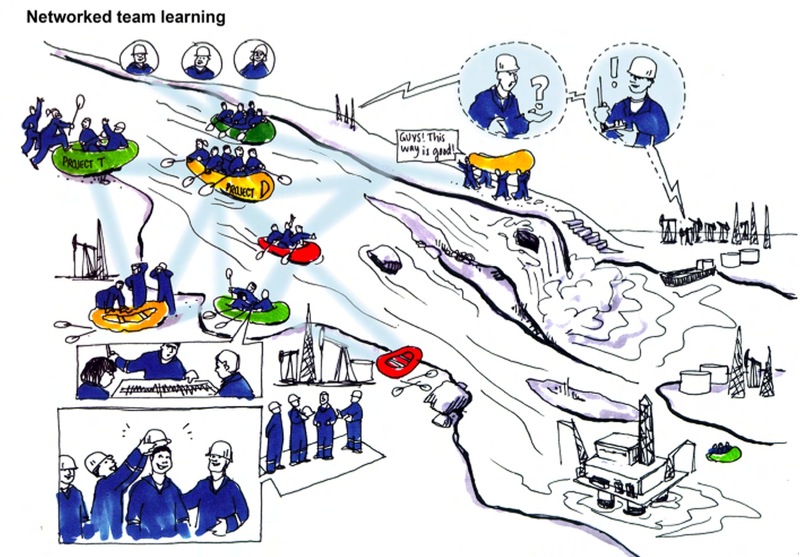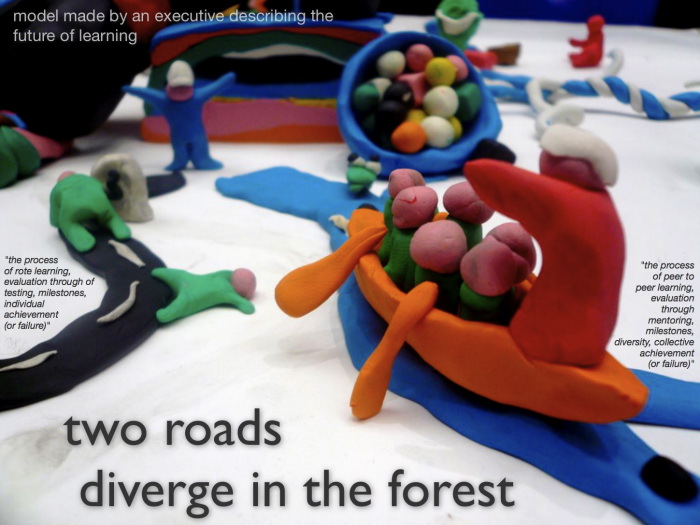Future of Learning 2015+ for Technical Knowledge, Documentation, Collaboration
For petro-technicians, learning is not a loose situation. It can be a matter of life and death. Companies must have deep knowledge about effective ways to bring knowledge, information and content to field operations. It requires a clear priority on galvanizing the competence and autonomy of these professionals to make sound judgment. An oil field services major, Schlumberger is a known leader in knowledge management, talent recruitment and training. With industry shortages in seasoned professionals, scenario development offered a way to better understand the future for training and knowledge in the technical arena.
The DTN’s global scenario process involved participants, experts and workshops across multiple countries and continents. It challenged the executive team to think outside their comfort zones. How will the Millennials consume knowledge? Can workers be trained to leverage Web 2.0 technologies? How will content be created? How will the transition occur to new models and modes of learning from current industrial-age methods? What delivery systems and architecture can we anticipate? The DTN’s high-level workshops were designed for inspirational context and imaginative content. Among the sites, the Marie Curie Centre in Paris, for the history of learning; the oil field engineering training centre in Oklahoma for contextual experience. To inspire other ways of knowing, an expert-led workshop took participants through learning-by-drawing, based on the work of Dr. Betty Edwards, “Drawing on the Right Side of the Brain”.
From the Driving Forces and Uncertainties
Bottom-up media: New technologies and distribution infrastructure are transforming who and how knowledge is created and disseminated. Consider the Wikipedia: an encyclopedia built in less than 5 years, a million pages larger than the Encyclopaedia Britannica, and a hundredth its size.
The Millennials: The first generation to grow up with digital technology, and to come of age when multimedia use – the Internet, computers, cell phones, and video games – is a way of life. Technology is used for self-expression, communication, entertainment and building social networks. Because of their demographic size and their distinct differences as a generational group, Millennials are expected to exert a major influence; especially not on workplace and learning.
Findings from Neuroscience: Neuroscientists have found that the brain changes with use throughout a person’s lifetime. The change is not simply psychological, but actually physical. The brain physically changes with learning, and, most extensively, when emotion is part of learning.
Play and the role of Microworlds, Simulation and Games: The best learning often takes place through playing. In playing with a transitional object – a representation of reality – the player can experiment without fear of consequences. There are three environments consistent with play and seen to be effective learning tools: microworlds, simulations and games.
Large-scale 3-dimesional environments: 3D environment technology has culminated in the emergence of virtual worlds like Linden Lab’s ‘Second Life’. Within ‘Second Life’, people can do or build just about anything and interact with other members from anywhere in the real world.
From global interviews across Europe, U.S. and Asia
Alan Kay, Computer scientist, President of Viewpoints Research Institute:We grow up with a pretty bad brain that’s been programmed by all the normal human culture and sense and so forth. Science is showing us just how bad our brain was.
Arie de Geus, Former Head of Planning, Shell: The ability to learn faster than the competition is the only sustainable advantage a company can have in the 21st Century.
Anne Jones, Founder and Managing Director, Lifelong Learning Systems: 18 to 21 is not the best time to be educated, quite honestly. What’s on your mind at the age of 18 to 21? Sex? Sports? Fun?
James Bradburne, Director, Next Generation Foundation:“We’re increasingly building a trust factor into technology…moving it from a person to a machine. [There’s] increasing displacement of intelligence into objects.




